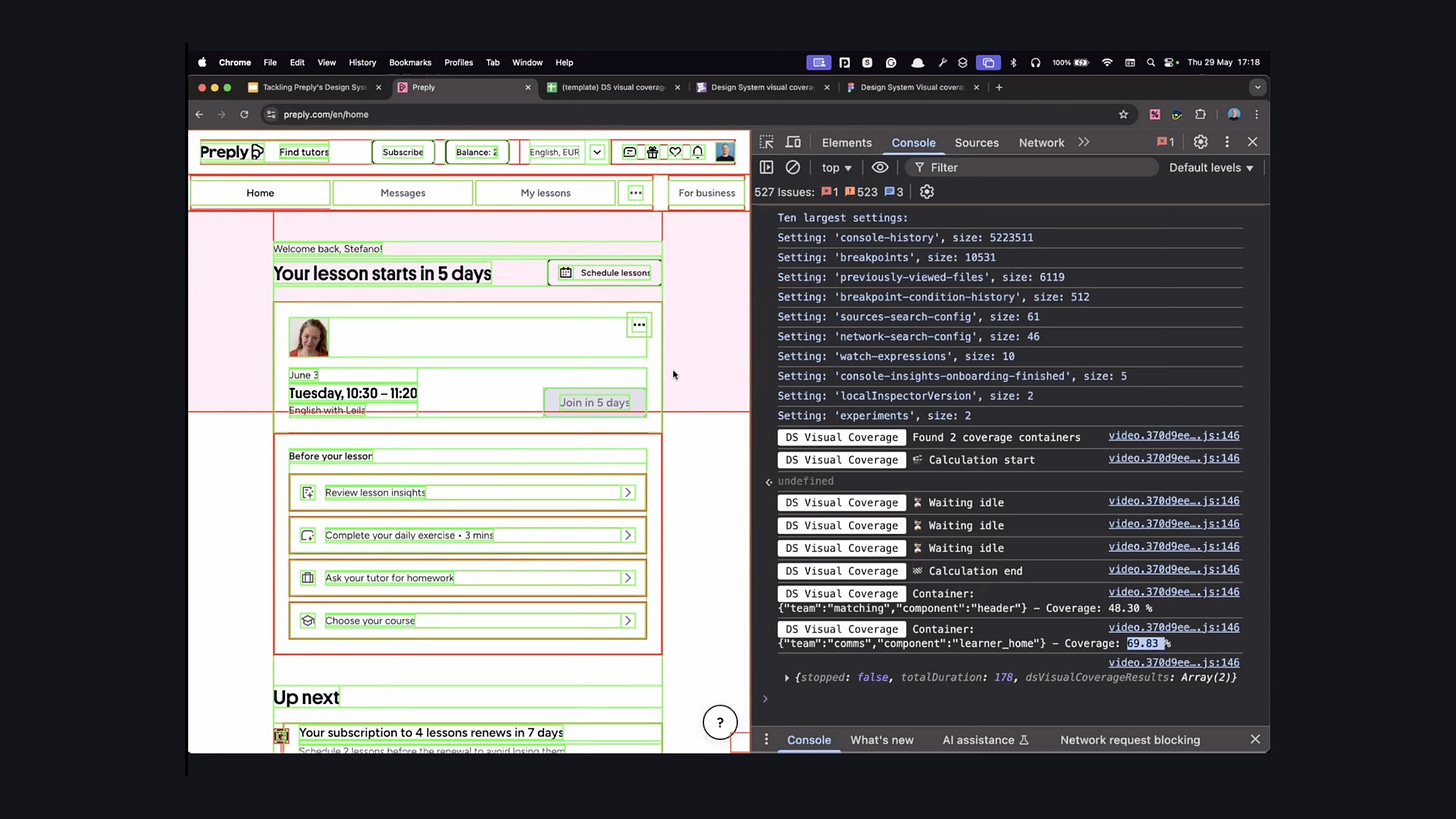Measuring Design System Impact - Lessons from Into Design Systems Conference
💰 How do you prove the value of your Design System to leadership?
📈 How do you track adoption in a way that actually reflects what users experience?
At Into Design Systems Conference 2025, Stefano Magni, Tech Lead at Preply, Design System shared one of the most advanced and thoughtful answers I’ve seen:
Visual Coverage
💡 It’s not just about counting components in Figma
It’s about measuring how much of your product, as seen by real users, is actually built with Design System components.
What is Visual Coverage?
Visual Coverage is a browser-based algorithm that runs directly on your users’ devices. It calculates how much of a given page is built with design system components. Not by counting DOM nodes or scanning codebases, but by analyzing rendered pixels.
Imagine coloring every component on the screen green if it comes from your system, and red if it doesn’t. Then counting those pixels to get a percentage.
That’s the core idea.
This makes the metric:
Product-oriented
Real-time
User-perspective driven
Why Preply Built It
Stefano explained the core problem like this:
“Design system metrics like token usage or static analysis are great — but they don’t speak the same language as product teams.”
Leadership cares about product data: conversion rates, engagement, usage trends. Preply’s platform teams needed something similarly tangible.
Something to show where the system is used, how much, and where it’s not helping enough.
So they built their own metric and made it open source.
How It Works
Here’s what makes Visual Coverage unique:
Pixel-based analysis: Calculates how much screen real estate is taken by system components
Component weighting: Not all components are equal. A primary button matters more than a layout div. Stefano built a scoring system using UI impact, interactivity, and accessibility
Team-level breakdowns: Tracks system usage by product team, so support and follow-up can be targeted
Live dashboards: Collected from 300,000+ measurements per day across Preply’s web and mobile apps
It’s implemented in pure JavaScript and works across frameworks. They even built a spreadsheet and a Figma file to help others get started.
Visual Coverage open-source project: https://github.com/preply/design-system-visual-coverage
What It Enables
Clear visual dashboards to show system usage to stakeholders
Insight into which teams are fully adopting the system — and which aren’t
Strategic conversations: Do we need more components? Or better ones?
A framework to support OKRs and adoption goals
A way to surface whether your system is supporting the most important business initiatives
And because it runs on user devices, it scales across the entire product footprint — without depending on product teams to integrate tracking code.
What You Can Do Next
Here are some concrete steps if you want to try this approach:
Explore the open source visual coverage library
Build a component weighting model for your system
Start testing the metric on key flows
Visualize adoption across teams or areas of the product
Use insights to inform your roadmap and stakeholder communication
“Visual Coverage is not a judgment metric. It’s a success metric.” — Stefano
It’s not about blaming teams with low adoption.
It’s about understanding where your system helps and where it doesn’t (yet).
🗂️ Get the Resources, Templates and Miro Access
After his talk, Stefano shared even more resources in the official Into Design Systems Miro board, available to ticket holders and everyone who purchases access to the recordings.
Stefano also answered key follow-up questions from the community, including:
What if we design products where we don’t have easy or any access to user data?
What is the definition of “impact” in the case of Preply’s design system? What exactly are you measuring?
How do you track visual coverage on mobile apps?
How are you using the visual coverage percentage to drive adoption? Is it part of product team goals or your own team’s goals?
💡 Want to go deeper and see everything Stefano shared?
You’ll get access to:
All recordings from the conference
The shared Miro board
Slides, templates, links and code examples
Resources from 20+ other expert sessions
Learn about Design Systems, Design Tokens, Accessibility, Documentation, and more
👉 Get instant access to all recordings and resources





